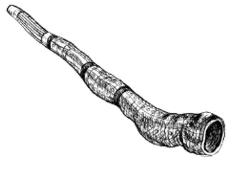 |
Didgeridoos: Traditional Playing
In Eastern Arnhem Land an overblown tone is sounded which may be one of several intervals ranging from a seventh to an eleventh above the fundamental, though a tenth seems to be more usual.
|
Alternating with the fundamental, the overtone is used both structurally, in relation to the song item as a whole, and according to the experience and expertise of individual players.
Based on the presence, or absence, of the overtone, didjeridu song accompaniments have been divided into the following two classes: A-type, in which the fundamental supplies a continuous drone, either accented by slight pitch infections or 'coloured' by the superimposition of a vocalised sound which the overtone is described above.
In the map showing the present (1960-70) distribution of the didjeridu (the same symbol (black dot) has been used for both types. A-type accompaniments are more widely distributed. They are to be found among groups on Goulbourn and Croker Islands, on the Arnhem Land mainland west of the Liverpool river, in west coastal regions north and south of Darwin, south into Kimberley districts, and along a route which extends from Oenpelli in the north-west, south-east through Bamyili into a region south of the Gulf and across the Queensland border B-type accompaniments have been found in association with songs belonging to groups east of the Liverpool river extending to the east coast of the Arnhem Land Reserve and including Groote Eylandt.
 |
Didgeridoos: Traditional Playing
It should be noted here that song types distinguished by A-type and B-type didjeridu accompaniments are performed by members of groups speaking 'pre-fixing' and 'Yuulngu' languages respectively.
Heath (maintains that, within the overall Australian linguistic picture, 'the prefixing languages of Arnhem Land and the Yuulngu languages are as remote from each other genetically as any two subgroups in the continent'; and that 'the two have come into contact due to migrations, after having evolved quite separately in different parts of the continent'. The linguistic picture highlights the present music scenario.
|
Despite continuing cross-fertilisation of stylistic features in the song performances of the Yuulngu of the one hand, and adjacent groups which include the Nunggubuyu (farther south) and Enindilyakwa speakers (Groote Eylandt) on the other, there are disparate elements in the music of pre-fixing and Yuulngu groups some of which may have been even more clearly apparent during an earlier period.
The Didgeridoo is not normally played as a solo instrument. It contains to a well integrated musical ensemble in which the chief participant, usually the song owner, sings as he beats together two hand sticks. In such ensembles there may be two or more stick-beating singers but never more than one didjeridu player. In eastern parts of Arnhem Land (fig.1, area 'N') the B-type player may also beat a stick against the tube of the instrument to synchronise with the singer's stick beats; alternatively he may flick the tube with his finger.
When seated, B-type player usually rests the distal end of the instrument on the ground or inside a box or bucket for resonance. Traditionally the resonator was bailer shell. A seated A-type player holds the distal end above the ground, either moving it slightly from side to side, or resting it on his upturned foot. This requires a two-handed grip. The right arm of the player may rest on his right knee which is bent, giving mid-way support either by a right-handed grip or allowing the tube to the tube to rest on his right wrist. With his other hand he grips the tube at the narrow end nearest his
|